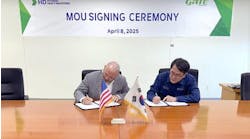Rick Von Flatern
Houston
A 1-in. string of composite coiled tubing was tested to 7,500 psi on the spool and off in a Duncan, Oklahoma test well.
Seek and retrieve: closed loop systems by year 2000
The introduction of computers to the drill floor has gone a long way toward removing personnel from harm's way and increasing efficiency. But, sophisticated as an iron roughneck or computerized pipe handler may appear, it is by most reckoning just the beginning of how computers will change the way wells are drilled. In time, probably by 2000, computers will be working downhole just behind the bit to, among other things, manipulate adjustable stabilizers. Taking a cue from the early days of side-tracking and directional drilling, instructions sent from computers at the surface will alter the well path by retracting or extending adjustable stabilizer blades.
Taken a step further, the BHA would take its instructions not from a program entered at the surface and based on stabilizer changes to be initiated at a predetermined depth and departure, but from a closed system in which instructions to the stabilizer are generated from LWD measurements. And, as companies add sonic logs to their LWD arsenals and develop formation evaluation while drilling (as several have), these high-tech drilling solutions could conceivably be programmed to drill according to seismic correlations and thus become exploratory as well as very precise development drilling tools. Besides further removing human frailty from the drilling process, once perfected this system would also allow many directional wells to be drilled without the heart of most current horizontal and extended reach drilling assemblies - the downhole motor.
The individual components for such advanced drilling systems exist and the concepts are being tested by a few operators and service companies. The remaining task is to package the technology as a cost-effective tool.
Smart wells and intelligent completions
Halliburton announced on September 16 that it had signed a letter of intent to establish an alliance with Petroleum Engineering Services for the development and delivery of "intelligent completion systems." On the same day, in nearly identical language, Schlumberger and Baker Hughes announced they had allied in pursuit of the same product. Intelligent completions, or smart wells, use surface controls to manipulate downhole tools such as plugs and sliding sleeves without well intervention. In horizontal, high-angle, and multilateral wells the cost advantage of production management without risky well intervention is considerable. The Schlumberger-Baker alliance is committing a combined investment of $50 million for the development of smart well products over the next several years. Halliburton-PSE was not so specific.
But besides the significance of the technology being developed (and it is indeed significant), is the lesson of the timing of the two press releases. Not that two alliances declaring themselves on the same day is much of a coincidence at a time when alliances are forming daily. But the fact both newcomers address the same new concept points up an interesting facet to the modern oil industry. It brings to mind innovators' old complaints that successful new products are public property before their inventors can cash in on them. The free exchange of information between and among service companies and operators that has become the hallmark of the oil industry in the 1990s, is carried on open lines anyone can tap. That competing companies tap the same conversations and react in like manner and time frame should surprise no one. The complaint of creative thinkers may become that not only are their innovative products in the public domain too soon, but so are their ideas.
Composite material in coiled tubing
In 1993, Conoco and Fiberspar, a manufacturer of various composite material products, began a joint program to develop a spoolable composite tube. Two years and thousands of short test-sections later, Conoco was out of the project, Halliburton Energy Services was in, and Fiberspar was the owner of more than 20 rights and patents for the manufacture of coiled tubing from carbon, kevlar, and glass fibers imbedded in an epoxy matrix and lined with a thermoplastic liner. While composite will never entirely replace steel coiled tubing, its extreme fatigue resistance gives it certain advantages over non-steel tubing. Composites hold up so well to cycling that they are more likely to wear out than to suffer fatigue-induced failure. In practical terms this means that though steel may have an initial higher pressure- or stress-rating than a comparable composite tube, repeated cycling may reduce the steel's ratings to below that of the composite.
But the material's most obvious advantage over steel is its weight - about 1/4 that of steel in air and about 1/7 in water. It's relatively modest weight permits strings to be loaded on smaller, lighter spools originally designed for smaller-OD steel coiled tubing, no small attraction for an industry moving constantly into deeper water and more remote locations where large and heavy spools can cause significant logistics problems.
Composite coiled tubing strings are not without drawbacks, of course. They are more susceptible to buckling than steel. Their standard price tag can be as much as ten times that of steel and in more than 200°F their thermoplastic liners become very expensive. Reparability in the field, accomplished with relative ease by welding steel, is problematic, if not impossible, with composite material.
Halliburton expects a work string in the field within a year and Fiberspar is proposing a "Joint Industry Project for Qualification of Fiberspar Spoolable Pipe for Offshore Applications." The three-phase project includes identifying and prioritizing three potential applications, fabricating and testing sections, and fabrication of a 15-m section for full scale testing. Major operators have expressed more than a little interest.
Copyright 1997 Oil & Gas Journal. All Rights Reserved.




